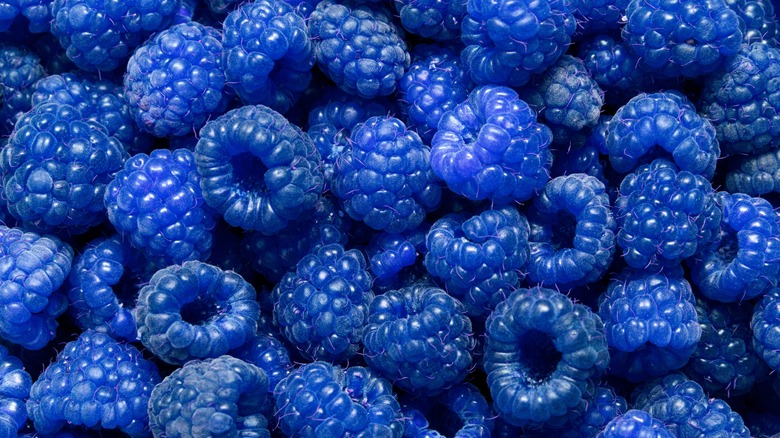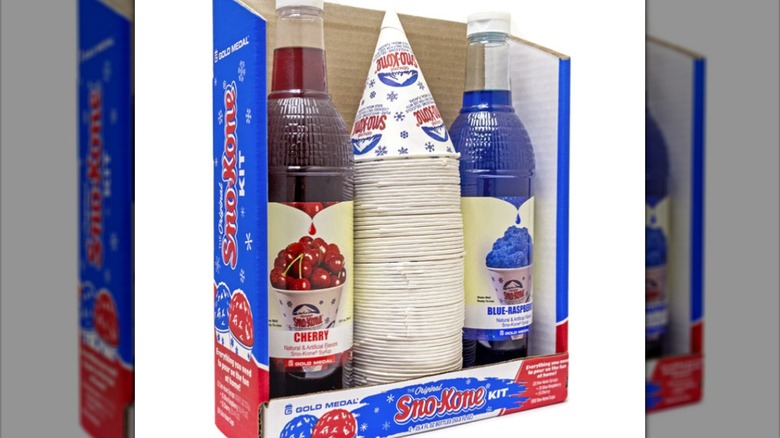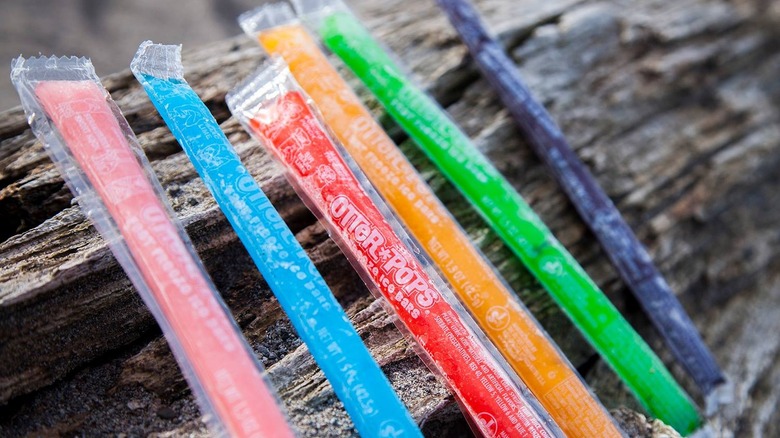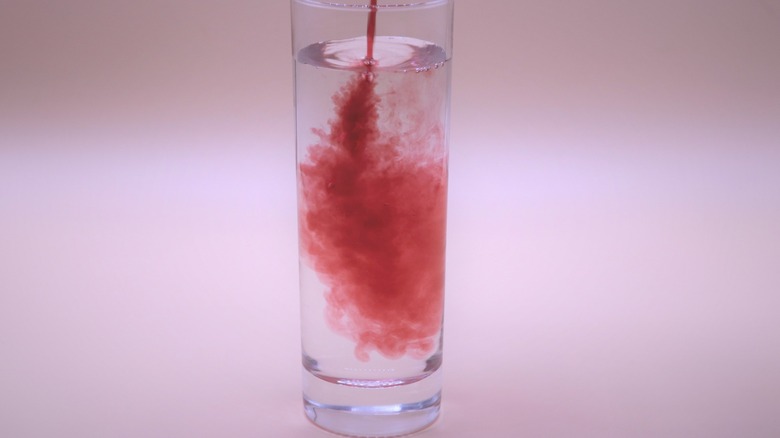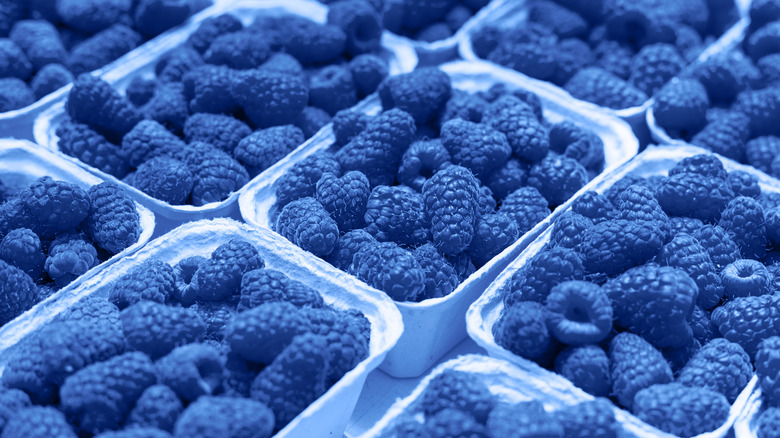The Strange Origin Of Blue Raspberry
Flavors that don't come directly from real foods (made-up flavors, if you will) are nothing new. Just take a look at Monster drinks, which feature cans in "Ultra Gold," "Ultra Paradise," and "Ultra Violet" variations that leave you guessing as to which fruits these flavors are based on. But there is no made-up flavor more well-known, and possibly more confusing, than blue raspberry. Do blue raspberries actually exist? And what are they supposed to taste like?
Unlike red, purple, and yellow raspberries, which are real fruits found in nature, blue raspberry is a flavor that was concocted in a lab. 7-Eleven explains that the taste of its blue raspberry Slurpee is "extracted from the vibrant blue raspberry bushes on the secret island of Razzmus," before teasing that folks should keep that a secret, while other companies describe blue raspberry as a mere blend of various flavors. It seems that every brand has a slightly different take on the flavor, and that may have to do with the strange origin story of blue raspberry.
Who came up with blue raspberry?
To figure out where the blue raspberry flavor began, we have to take a closer look at a company called Gold Medal. It still exists today — you can find it on Amazon or on the company website where it sells blue raspberry cotton candy floss sugar and an array of sweet and savory treats. The brand was founded in 1931, and originally became successful selling ice shavings with Klix Kola syrup (aka snow cones), since sugar was scarce during World War II. A 1958 article talks about a novel blue raspberry flavor that Gold Medal was advertising for its snow cones and cotton candy floss, along with a grape-purple flavor. At the time, blueberries weren't very popular, so the new blue-ish treats were meant to bring more attention to the raspberry flavor, since it got lost amongst other red products with cherry, watermelon, and strawberry. Gold Medal used a dye called "Brilliant Blue" to achieve the color.
This may be the earliest recorded incident of blue raspberry appearing on the scene, so it's possible to credit Gold Medal with the creation of the flavor. But it didn't really take off until 1976 when the brand began to mass market it for its sweet treats.
How did blue raspberry become a popular flavor?
Blue raspberry really became popular in the U.S. in the 1970s, and it was particularly exciting for kids who enjoyed the vivid color. Around this time, other brands caught onto the flavor and started using it to sell their raspberry products. One of those companies still remains an iconic producer of blue raspberry beverages to this day: ICEE. Back in 1970, the brand debuted the flavor with the same ingredients as its raspberry treat, but with an added bright blue dye called FD&C Blue No. 1. As The ICEE Company's vice president of marketing, Susan Woods, told Bon Appétit, "Raspberry tasted great as a frozen beverage. However, we wanted something that was a distinctly different color than our flagship flavor, cherry. The color of blue raspberry flavor was strongly inspired by the blue color that is part of the ICEE brand." Even today, the blue raspberry ICEE flavor logo includes the phrase "The Original," and the frozen treat contains FD&C Blue No. 1.
Otter Pops also helped popularize the flavor in the '70s through its Louie Bloo Raspberry pop. To this day, Louie Bloo Raspberry is a character of the brand proclaimed to be an artistic and creative soul who speaks with a French accent.
The FDA banned a red food dye used in raspberry-flavored products
While Gold Medal, ICEE, and Otter Pops each used blue raspberry as a way to separate their products from all the red treats out there, there was another major factor that contributed to the flavor's creation. Back in 1958 — the same year Gold Medal promoted its new blue raspberry snow cone — the U.S. Food and Drug Administration (FDA) passed the Food Additives Amendment, which said that the FDA needed to approve the safety of food additives. Before then, these ingredients were assumed to be safe until proven otherwise.
In the 1950s, a wine-red dye called FD&C Red No. 2 was the primary coloring additive included in raspberry-flavored foods, but there were rumblings that the dye wasn't safe to consume. Then in 1976, the FDA banned FD&C Red No. 2 after several studies demonstrated its toxicity. It was one of the most common color additives in the U.S. prior to the ban, and was included in billions of dollars worth of food. So, when the dye could no longer be used, it left big shoes to be filled and brands took the opportunity to use FD&C Blue No. 1 instead, which the FDA approved for food usage in 1969.
Do blue raspberries exist in nature?
The short answer is no, at least not how we think of them. Bright blue, sweet and sour raspberries cannot be found in nature. However, there is a darker version of these fruits called the whitebark raspberry, or Rubus leucodermis. When ripe, they look more like blackberries than raspberries — which is why they also go by the names black raspberry and blackcap — and can range anywhere from purple to black. Their juice is sometimes used as purple dye for packaging materials, but not as a color additive for blue raspberry-flavored products.
The tangy flavor of whitebark raspberries may have inspired the blue raspberry flavor, at least in part. These purple types taste more like blackberries than red raspberries, though, and if you've ever had a blue raspberry ICEE, you know that you get a jolt of sweetness when you take a sip, unlike the more sour whitebark fruits. So, while the purple berries may have sparked the imagination of the inventors of blue raspberry, each brand now has its own version of the artificial flavor — hence the blue raspberry bushes from the secret island of Razzmus allegedly contained in the 7-Eleven Slurpee.
